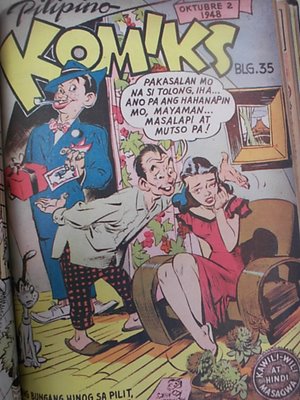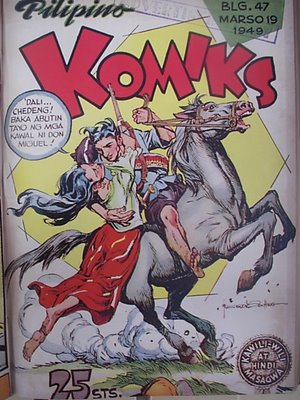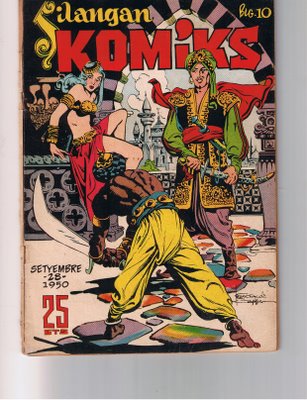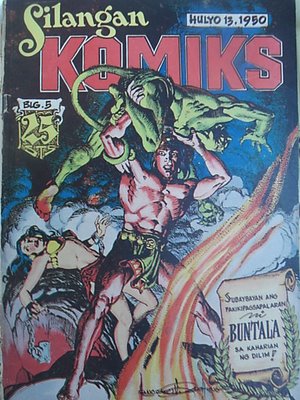I was fortunate to have a free afternoon last Saturday (october 21), to attend the 2nd annual KOMIKON, a local mini version of the San Diego Comics Convention.
I really did plan to set a booth there to sell some old komiks and original arts but at the last minute i decided to just be a spectator, so I can visit my friends' respective booths and give support to their comics creations.
I arrived almost 3 O'clock in the afternoon, so I already missed some activities in the morning. But I was glad to see some of my friends there like Erwin Cruz(Cruzifix), Gerry Alanguilan, Randy Valiente, and the illustrator Mario Macalindong.
I also purchased several new comic books like Alanguilan's ELMER, Manix Abrera's KIKO MACHINE 2, KC Cordero's Filipino Komiks #1, as well as some indie comics by young comics creators. It is important for me to support their efforts to continue the tradition of comics making in the Philippines.
I am very impressed with the enthusiasm and the energy manifested by these people when it comes to local comics. With them leading the way, it would come as no surprise if the once glorious era of Philippine comics will be revived, which is a sort of Renaissance.
I am very enthusiastic with Gerry's Elmer, a modern fable about chickens freely interacting, living, and even marrying with humans. Whoa..if you haven't read it yet, go buy one from your local comics dealer (ComicQuest or Filbars), and you'll certainly like the poignancy of the story(even if it's not yet complete..parts 3 and 4 are still in the making).
I salute Gerry for having the courage to come out with his own publishing company at a time when the comics industry is at its ebb. Will it take a chicken to revive the industry? Hehe that is a great great possibility since Elmer is a great great comic book.
I also commend the efforts of former Atlas Editor KC Cordero for spearheading the publication of Filipino Komiks#1, an attempt to revive the comics industry from its very roots. Some of the contributors to this comics are veterans of the Philippine comics industry like writer Joemari Lee, and illustrators Randy Valiente, Carl Comendador, Gibert Monsanto, Dante Barreno, Rico Rival, Nar Castro, and many others.
I am also very pleasantly surprised to find out that once again the ALCALA LEGACY has an exhibit of Alfredo Alcala's original works. I marvelled at the artworks of Voltar, Ukala, Yamato, and some other very rare pieces of comic art from the master's personal collection. What a great collection it is and deserves a permanent place in a museum devoted to comic art.
I didn't have enough time though to visit everyone like Reno Maniquis, who is managing the Mars Ravelo booth, Gilbert Monsanto, and Carlo Vergara. I have wanted to see them but it was already getting late, and I know they're very busy, too.
Lastly, I was very pleased to meet some of the veterans from the Golden Age of Philippine comics. It is very heartwarming that they went there to show that the love for comics is always in their blood. I didn't want to go without a picture of all of us..so it's here:

Left to Right: Nar Castro, Yong Montano, Jess Jodloman(Alex Nino's teacher!), Mar Macalindong, Me(as in, me), and collector and comics archivist Orvy Jundis (Thanks to Erwin Cruz for this photo)
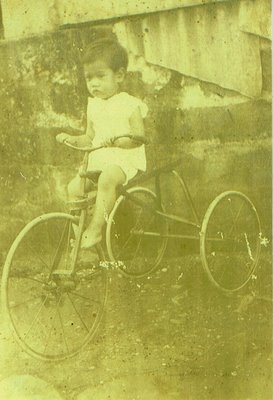
 Tony Velasquez, age 5, circa 1916. Unknown to many, Tony Velasquez was a vistuoso violinist who studied under the great Filipino composer, Bonifacio Abdon.
Tony Velasquez, age 5, circa 1916. Unknown to many, Tony Velasquez was a vistuoso violinist who studied under the great Filipino composer, Bonifacio Abdon.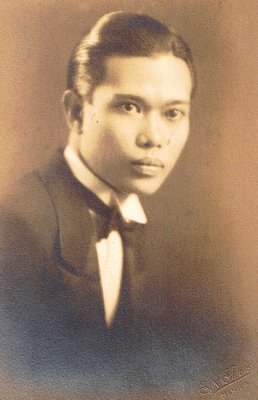 Studio Portrait, taken the year Kenkoy was born in the pages of the Liwayway in 1929.
Studio Portrait, taken the year Kenkoy was born in the pages of the Liwayway in 1929. The Don Ramon Roces Swimming Team, circa 1936.
The Don Ramon Roces Swimming Team, circa 1936. The very first Kenkoy greeting card sent by Tony Velasquez to Ms. Pilar Tongco, during the Japanese Occupation, 1943. Tony Velasquez was employed as graphic artist by the HODOBU, a Japanese information service bureau located in Escolta. Ms. Pilar Tongco was employed as librarian there.
The very first Kenkoy greeting card sent by Tony Velasquez to Ms. Pilar Tongco, during the Japanese Occupation, 1943. Tony Velasquez was employed as graphic artist by the HODOBU, a Japanese information service bureau located in Escolta. Ms. Pilar Tongco was employed as librarian there. A Kenkoy Birthday Card sent to Ms. Pilar Tongco during the last year of the Japanese Occupation, 1944.
A Kenkoy Birthday Card sent to Ms. Pilar Tongco during the last year of the Japanese Occupation, 1944. Velasquez in 1946, right after the founding of Ace Publications and Pilipino Komiks, 1947.
Velasquez in 1946, right after the founding of Ace Publications and Pilipino Komiks, 1947. Cover of Pioneer Komiks #113 by the great Filipino international illustrator Alex Nino.
Cover of Pioneer Komiks #113 by the great Filipino international illustrator Alex Nino.

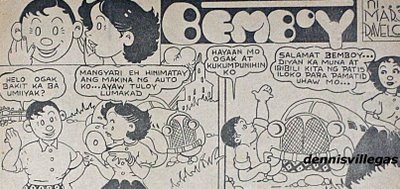
 Left to Right: Nar Castro, Yong Montano, Jess Jodloman(Alex Nino's teacher!), Mar Macalindong, Me(as in, me), and collector and comics archivist Orvy Jundis (Thanks to Erwin Cruz for this photo)
Left to Right: Nar Castro, Yong Montano, Jess Jodloman(Alex Nino's teacher!), Mar Macalindong, Me(as in, me), and collector and comics archivist Orvy Jundis (Thanks to Erwin Cruz for this photo)
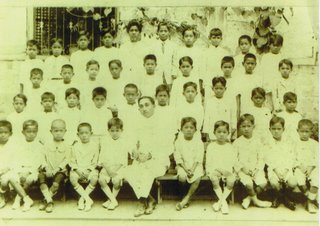
 Studio Portrait 1929, around the time of the birth of Kenkoy
Studio Portrait 1929, around the time of the birth of Kenkoy Ms. Pilar Tongco, the real-life Rosing of the Kenkoy Album, circa 1943
Ms. Pilar Tongco, the real-life Rosing of the Kenkoy Album, circa 1943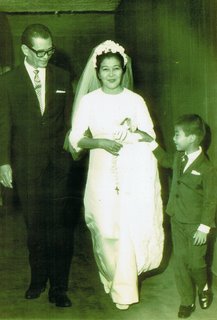 The long-awaited marriage finally happened in 1967
The long-awaited marriage finally happened in 1967 When they were kings...the kings of komiks in a rare photograph taken while on a beach holiday, circa 1958. Tony Velasquez is second from left, first row.
When they were kings...the kings of komiks in a rare photograph taken while on a beach holiday, circa 1958. Tony Velasquez is second from left, first row.



 Bing Bigotilyo is Francisco V. Coching's first cartoon character. It first appeared in the Silahis Magazine in late 1930s, was censored during the Japanese occupation, and continued after the war. Although Coching was more well known for his serious comic art, which by the way influenced generations of Philippine comics artists, yet unknown to many, he started out his career as a cartoonist in the Silahis Magazine. His style of cartooning was different from the style of Tony Velasquez or Francisco Reyes, but more in the vein of style by Mauro Malang and Romeo Tabuena.
Bing Bigotilyo is Francisco V. Coching's first cartoon character. It first appeared in the Silahis Magazine in late 1930s, was censored during the Japanese occupation, and continued after the war. Although Coching was more well known for his serious comic art, which by the way influenced generations of Philippine comics artists, yet unknown to many, he started out his career as a cartoonist in the Silahis Magazine. His style of cartooning was different from the style of Tony Velasquez or Francisco Reyes, but more in the vein of style by Mauro Malang and Romeo Tabuena.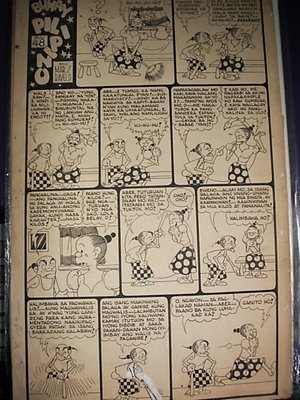
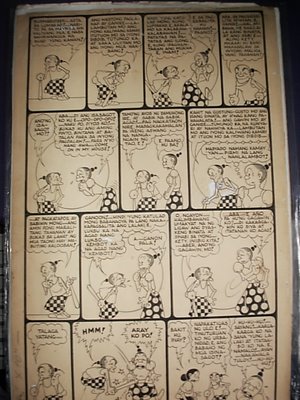 Mars Ravelo's BUHAY PILIPINO may well be the master's greatest work, and for a reason. It was Ravelo's most popular and enduring work. I really think that Ravelo was at the height of his writing prowess when he created Buhay Pilipino. It was more than a comic strip, it reflected the very life of the typical Filipino family of those golden years. More than any other cartoon strip, Ravelo manifested his deep knowledge of sociology and psychology in Buhay Pilipino.
Mars Ravelo's BUHAY PILIPINO may well be the master's greatest work, and for a reason. It was Ravelo's most popular and enduring work. I really think that Ravelo was at the height of his writing prowess when he created Buhay Pilipino. It was more than a comic strip, it reflected the very life of the typical Filipino family of those golden years. More than any other cartoon strip, Ravelo manifested his deep knowledge of sociology and psychology in Buhay Pilipino.  One of Larry Alcala's most famous cartoon characters, Asyong Aksaya dubuted in the Tagalog Komiks in the 1970s. It was later adapted into a movie starring Chiquito in the extravagant title role.
One of Larry Alcala's most famous cartoon characters, Asyong Aksaya dubuted in the Tagalog Komiks in the 1970s. It was later adapted into a movie starring Chiquito in the extravagant title role.
 A contemporary of Tony Velasquez, Jose Zabala-Santos and J.M. Perez, Francisco Reyes great contribution to Philippine cartoon art is his immortal KULAFU. Of course, none of us younger geneartion living today will know that, because Kulafu existed only during the pre-war years of Philippine cartooning.
A contemporary of Tony Velasquez, Jose Zabala-Santos and J.M. Perez, Francisco Reyes great contribution to Philippine cartoon art is his immortal KULAFU. Of course, none of us younger geneartion living today will know that, because Kulafu existed only during the pre-war years of Philippine cartooning.  Kenkoy, the first Filipino cartoon character, with his creator Tony Velasquez (aged 19) in the background, the recognized Father of the Tagalog Comics. (This is actually an old Kenkoy figurine doll from the collection of Tony Velasquez, and I placed his vintage picture from 1929 as a background)
Kenkoy, the first Filipino cartoon character, with his creator Tony Velasquez (aged 19) in the background, the recognized Father of the Tagalog Comics. (This is actually an old Kenkoy figurine doll from the collection of Tony Velasquez, and I placed his vintage picture from 1929 as a background)

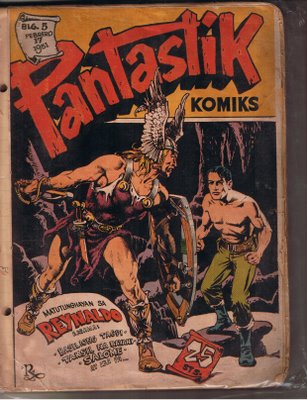
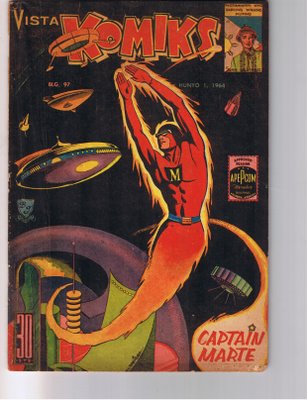




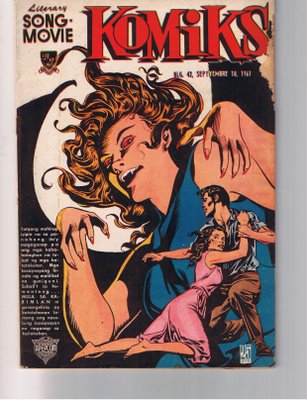

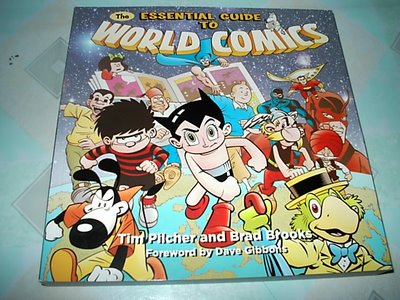
 A special two-page spread tribute to Tony Velasquez, father of Philippine Comics.
A special two-page spread tribute to Tony Velasquez, father of Philippine Comics.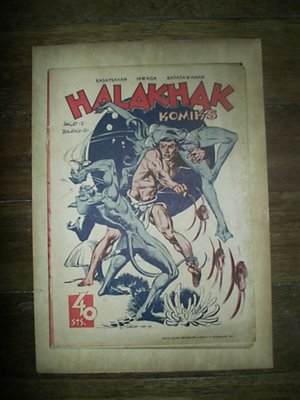 Halakhak Komiks #9, 1946. This is the only Coching cover for the extremely rare Halakhak Komiks, featuring Bulalakaw, one of his early komiks characters.
Halakhak Komiks #9, 1946. This is the only Coching cover for the extremely rare Halakhak Komiks, featuring Bulalakaw, one of his early komiks characters. Liwayway Cover, Issue for October 9, 1947
Liwayway Cover, Issue for October 9, 1947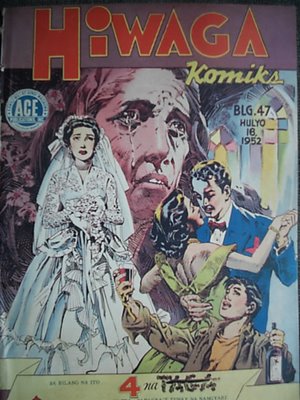 Hiwaga Komiks#47, July 16, 1952
Hiwaga Komiks#47, July 16, 1952
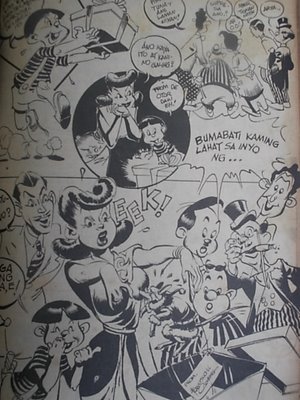 Paloma, the first cartoon character of Coching in Pilipino Komiks, 1947.
Paloma, the first cartoon character of Coching in Pilipino Komiks, 1947.